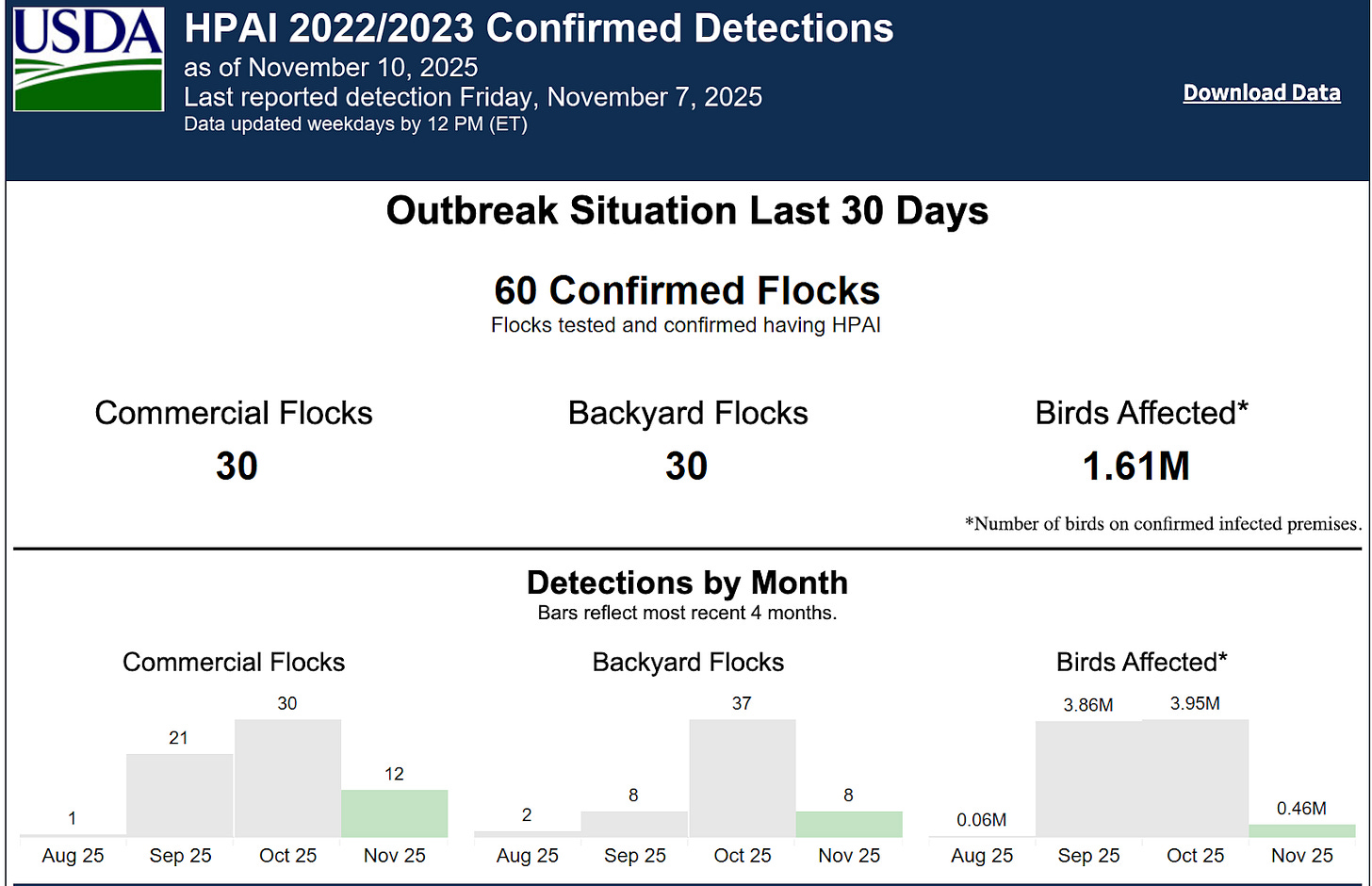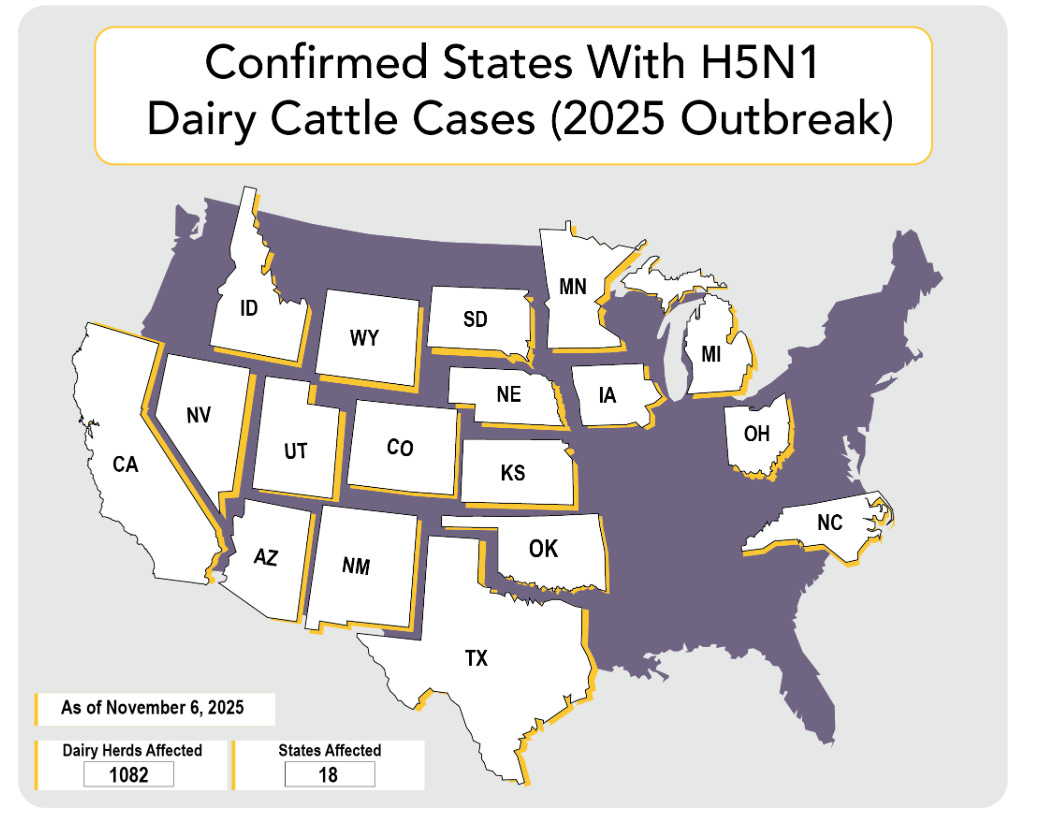Unfortunately, bird flu is still circulating, and you will likely start hearing more about it as flu season picks up. Let’s recap why we care about bird flu and what we currently know.
Note: In the U.S., some of the data updating is delayed due to the ongoing government shutdown and changes within the administration. These data are what we currently have access to and are up to date as of September for human cases and October/November for cows and chickens.
What is Bird Flu?
Bird flu, also called avian flu or H5N1, is a type of flu that mainly affects birds. There are different kinds of avian flu. Some are low pathogenic (LPAI), meaning they usually don’t make birds very sick, while others are highly pathogenic (HPAI), meaning they can cause severe illness or death in birds.
HPAI has been increasingly infecting more animals. Because it is spreading more in animals, particularly in mammals, scientists and other professionals are closely watching the situation develop.
Why do we care that it’s infecting more animals?
At this point in time, most cases of H5N1 that we have detected in humans have been caught directly from contact with an infected animal. This is because this version of the flu virus is not good at spreading from human to human. But the more a virus spreads, the more chances it gets to make mistakes while making copies of itself, a process called mutation. Mutations are often nothing to be concerned about and some even prevent the virus from infecting or copying itself. But occasionally, mutations can end up being good for the virus. For example, giving it the ability to spread between humans.
This is why we are carefully watching bird flu as it spreads in more mammals, such as dairy cows. Humans are mammals, so the more the virus gets a chance to infect mammals, the more chances it has to adapt and become able to spread from human to human. We want to limit the chances the virus has to change!
So what is the state of bird flu in the US right now?
Good question! Earlier this summer, the Centers for Disease Control and Prevention (CDC) changed how it shares updates about bird flu, which makes it harder to know how much it’s spreading. So far, none of the 70 reported human cases (since early 2024) have spread from person to person. This is great news, but there has been one death. It’s also unclear whether there truly haven’t been any new cases or if fewer are being reported or tracked.
Without regular testing and reporting, we can’t be sure what’s really happening. Mild symptoms mean farm workers might not realize they’re sick or think to report it.
The US Department of Agriculture (USDA) still reports bird flu outbreaks in animals like cows and commercial chicken flocks, though. They update weekly for commercial chickens and backyard chicken flocks and most recently on October 10 for cows. Since the virus is still circulating in these animals, and most human cases happen after direct contact with sick animals, it’s possible we will see more human cases in the future.

Source: USDA – Animal and Plant Health Inspection Service (APHIS)

Source: Brown University Pandemic Center Tracking Report 11/6/25 (numbers correct as of 10/30/25 at 10 AM ET [Source APHIS] )
What can I do to protect myself?
🚫 Avoid raw milk and raw milk products. Pasteurized milk is safe as the pasteurization process kills the virus.
🚫 Don’t feed raw milk or raw food products to your pets.
🚫 Don’t let your pets play with sick or dead birds, and if you find any dead wild birds, report them.
🧤 If you have bird feeders in the backyard, make sure to wear gloves when cleaning or refilling them and thoroughly wash your hands afterward.
🐮 If you work or have contact with farm animals (including backyard chickens) please wear proper PPE because your risk of exposure is higher than the general public. CDC outlines resources for you here.
💉 Make sure you are vaccinated for the flu to reduce the chance you are infected with multiple flu strains at once.
‼️Hot off the press – early clinical trials show adults responded well to a nasal vaccine for H5N1. Now it’s important to stress that this is early days, and the trial was a phase one trial, so a small safety trial, but it is potentially good news and Those Nerdy Girls will watch this space for you!
Bottom line: Bird flu is not going away anytime soon, but for now, the risk to most of the public remains low. Rest assured that we are keeping an eye on this and will update you with any important news or changes.
Love,
Those Nerdy Girls
Useful links:
USDA – Confirmations of Highly Pathogenic Avian Influenza in backyard and commercial poultry flocks
USDA – HPAI confirmed cases in livestock
CDC – H5 Bird Flu: Current Situation [archived link]
CDC – Backyard Flock Owners: Protect yourself from bird flu [archived link]
Those Nerdy Girls – visit our website for a selection of posts on bird flu



